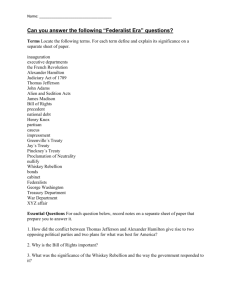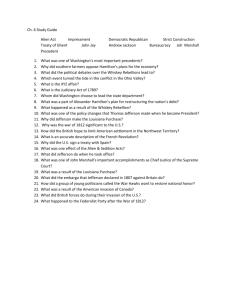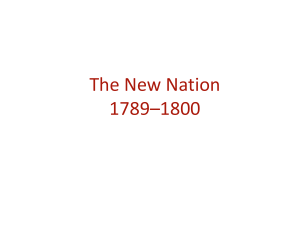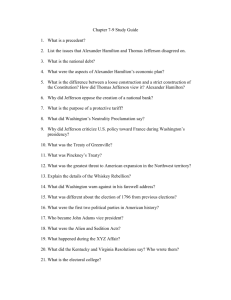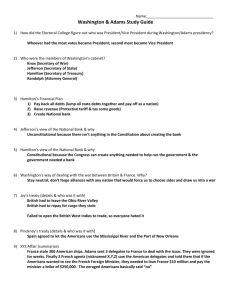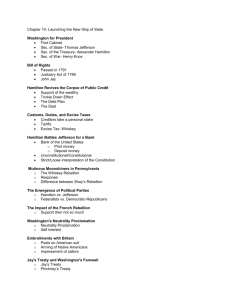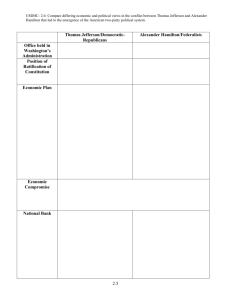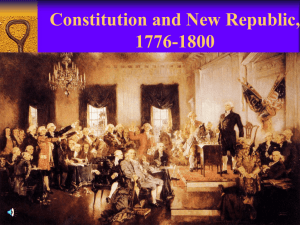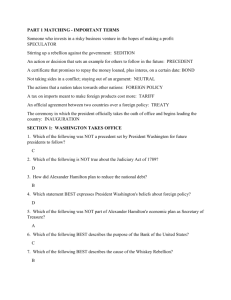George Washington's Presidency
advertisement
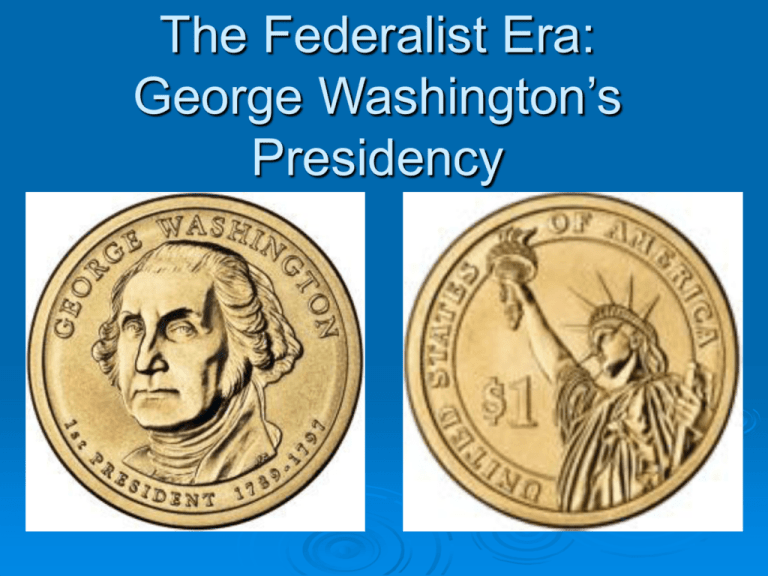
The Federalist Era: George Washington’s Presidency The Rise of Political Parties Parties – groups of people with similar political views During the ratification fight, 2 different groups emerged, Federalists and AntiFederalists Washington chose members of both parties to serve with him Political Was a strong figure that unified both parties • Neither side wanted to be against Washington The Rise of Political Parties Federalists – favored the Constitution, and a strong central government Alexander Hamilton Anti-Federalists (also known as DemocraticRepublicans, or Republicans) – originally opposed the Constitution, favored strong state government Thomas Jefferson 1st President Elected in 1789 Only president ever to be elected unanimously Runner up was John Adams, became VP Executive Departments Congress created three executive departments and Washington got to choose the heads of those depts. Washington began meeting regularly with the heads of the departments • For advice and assistance • First Cabinet Presidential Cabinet The First Presidential Cabinet Secretary of State – Thomas Jefferson Secretary of War – Henry Knox Secretary of Treasury – Alexander Hamilton Judicial Branch Judiciary Act of 1789 – created federal court system with 3 levels Established District and Appellate Courts Set the number of Supreme Court Justices at 6 Also created executive department of Justice and Attorney General • Edmund Randolph joined cabinet Edmund Randolph – 1st Attorney General Washington’s Cabinet Alexander Hamilton Only Immigrant Founding Father Father left and mother died Worked in the shipping business as a clerk Operated the business as a teen when owner was away Sent to New York for education Joined Continental Army British West Indies Aide to Washington Became lawyer Financial Genius Completely shaped US Financial System Alexander Hamilton and US Financial Policy 1. Pay off foreign war debt immediately and in full $11.7 Million (owed mostly to France) Only way to create confidence in new nation Alexander Hamilton and US Financial Policy 2. Buy back depreciated Revolutionary war bonds at face value US owed $40 million to citizens in war bonds Only way to establish trust in new nation • Government must do what it said it would Jefferson opposed plan • Rewarded speculators at the expense of the poor Alexander Hamilton and US Financial Policy 3. Assume State’s war debt $25 million dollar debt Would establish a federal line of credit Tie all states to Federal Government Establish support for Federal Government Help national economy by freeing up states’ money Alexander Hamilton and US Financial Policy 4. Create Bank of the United States Bank for Government money and loans 20 year charter Believed that the “necessary and proper” clause gave Congress power to charter Bank Helped US consolidate its debt and pay its creditors Offered stability to the US economy Foreign Issues French Revolution breaks out in 1789 Britain resumes fighting France Spain still has New Orleans blocked Washington’s Foreign Policy France The French Revolution started in 1789 Storming of the Bastille French uprising against monarchy of Louis XVI caused considerable violence and bloodshed The noble ideas of liberty, freedom, and the rights of man which started the revolution would turn to fear and tyranny • “Reign of Terror” Mass executions of enemies of the Revolution (18-40,000) This revolution would renew French hostilities with Britain Jefferson and the Anti-Federalists sided with the French and their push towards individual rights "The tree of liberty must be refreshed from time to time with the blood of patriots and tyrants. It is natural manure." - Thomas Jefferson Mob violence scared Hamilton, Federalists • Preferred the stability and order of Britain Neutrality Proclamation Did not want to take sides in regards to French Revolution Washington pursued a friendly and impartial conduct between the two nations Washington’s Foreign Policy Britain British still had not evacuated western forts Were using them to supply Indians on raids against American settlers Britain wanted to eliminate American Trade with the French • British capturing neutral American merchant ships in the French West Indies Jay’s Treaty Chief Justice John Jay was sent to Britain to negotiate treaty with British Both sides received some of their demands • British agreed to pay for seized ships, abandon frontier forts, and allow some Caribbean trade • American agreed to pay pre-revolutionary war debts to British merchants • British continued impressment of American sailors • Not incredibly helpful, but did prevent war with Britain Jefferson would disagree with treaty, feeling that it aligned US to closely with Britain • Became a divisive party issue Washington’s Foreign Policy Spain Spanish had closed port of New Orleans to Americans due to border disputes in 1784 Pinckney’s Treaty US Ambassador Thomas Pinckney was sent to Spain to negotiate a treaty Treaty was huge success • Re-opened New Orleans to American trade • Moved Florida border from mid Georgia to 31st parallel (close to current border) Washington’s Domestic Policy The Whiskey Rebellion Congress passed excise tax on American made Whiskey in 1791 To pay off national debt Pennsylvania farmers who couldn’t pay the tax rebelled • Tarred and feathered tax collectors • Skirmishes broke out between rebels and Federal officers Shots fired Rebels tarring and feathering a tax collector during the Whiskey Rebellion Washington’s Domestic Policy The Whiskey Rebellion Washington personally commanded nearly 13,000 troops to shut down the rebellion Most Rebels fled without battle • Washington captured 20 First major show of Federal Authority, Force • Washington WOULD see that the laws were executed • set a precedent that U.S. citizens who wished to change the law had to do so peacefully through constitutional means Washington’s Domestic Policy Northwest Territory Americans continued to settle in the Ohio Country north of the Ohio River British had ceded land to US after Rev. war Indians rallied around Little Turtle and went to war against settlers Indians felt land was theirs despite treaties Were supplied by British Washington sent General “Mad” Anthony Wayne to end the dispute Washington’s Domestic Policy Battle of Fallen Timbers August 20, 1794 Near Toledo, Ohio Wayne and his men chased the Indians back to Fort Miami British refused Indians access – did not want to start another war Americans routed Indians, burning their fields and villages Led to Treaty of Greenville in 1795 Indians gave Americans most of Ohio, Chicago, Detroit Americans gave Indians $20,000 worth of goods and acknowledged existing claims Battle of Fallen Timbers Washington’s Farewell Address Washington chose to step down after two terms in office (1789-1797) His farewell address is his most famous speech • Warns of political party divisions Political Unity was key to success • Warns about dangers of foreign entanglement No permanent friends or foes • Morality in government Washington’s Farewell Address by Allyn Cox – US Capitol Religion is instrumental
